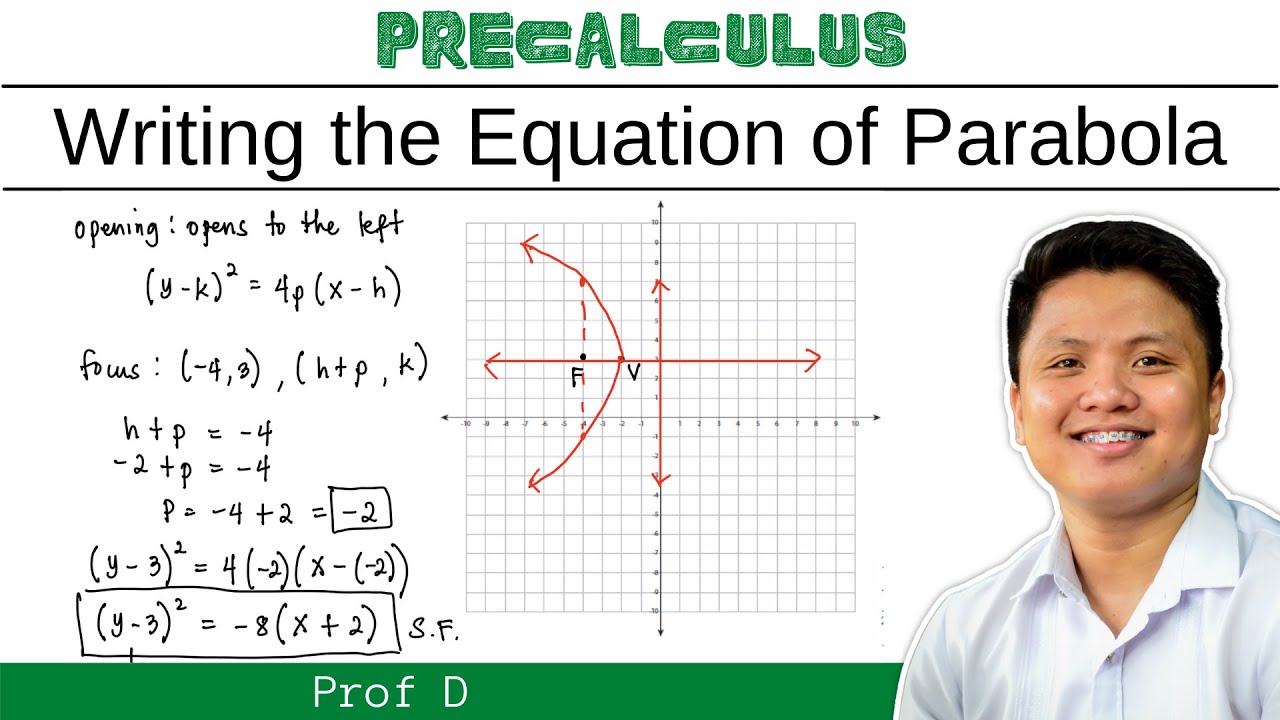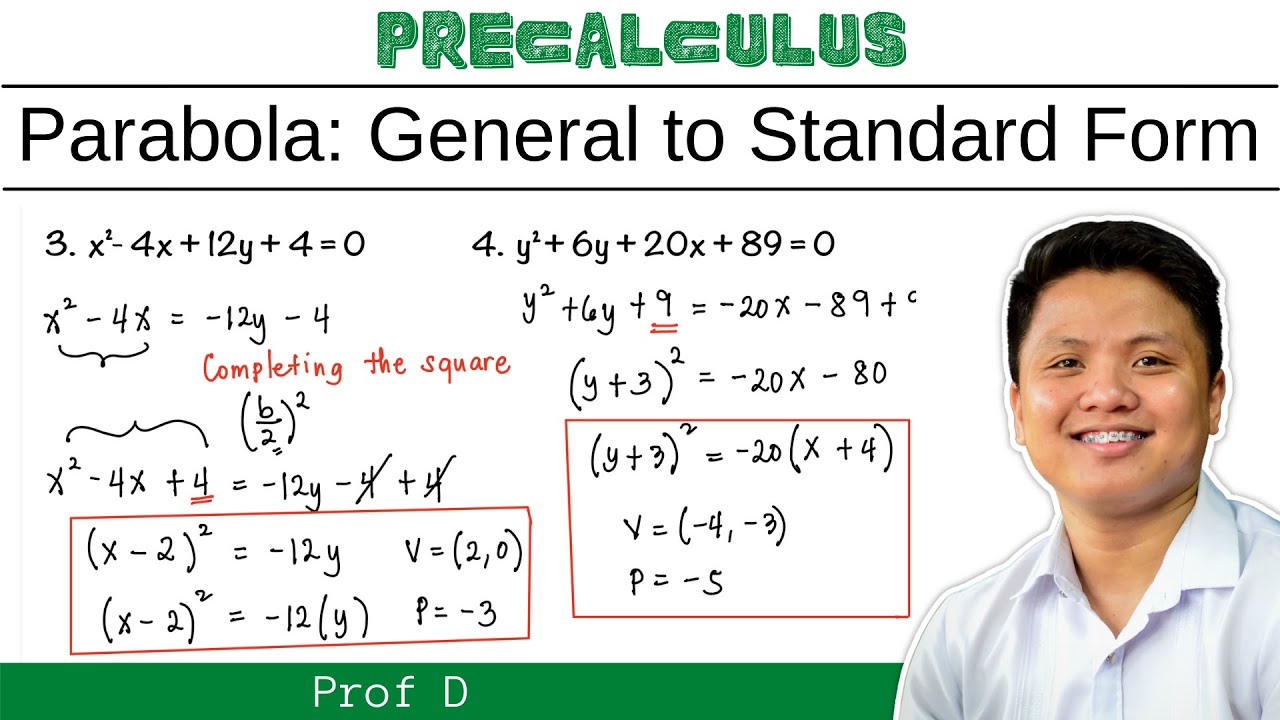Graphing ellipse with center at the origin | @Prof D
TLDRIn this video, Prof D demonstrates how to find the coordinates of the foci, vertices, and endpoints of the major and minor axes, as well as the lattice rectum for an ellipse centered at the origin. Using the equation 9x² + 16y² - 144 = 0, the video explains the process of converting it to standard form, identifying key parameters, and calculating specific points and lines, including the directrix. The detailed, step-by-step explanation ensures viewers understand the mathematical concepts involved. If you have questions, leave them in the comments. Thank you for watching!
Takeaways
- 📚 The video is a tutorial on finding the coordinates of various elements of an ellipse with its center at the origin.
- 🔍 It begins by providing an example of an ellipse equation that is not in standard form and guides through the process of rewriting it.
- ✍️ The standard form of an ellipse equation is given as \( \frac{x^2}{a^2} + \frac{y^2}{b^2} = 1 \), where \( a \) and \( b \) are the semi-major and semi-minor axes, respectively.
- 📐 The video explains how to identify the orientation of the ellipse (horizontal or vertical) based on the values of \( a \) and \( b \).
- 📏 It demonstrates the calculation of the semi-major axis \( a \) and semi-minor axis \( b \) from the given equation.
- 🧭 The formula for finding the distance \( c \) from the center to the foci of the ellipse is discussed, which is \( c = \sqrt{a^2 - b^2} \).
- 📍 The coordinates of the vertices and foci of the ellipse are calculated and presented in the video.
- 📉 The endpoints of both the major and minor axes are identified, which are key points on the ellipse.
- 📌 The video also covers the calculation of the endpoints of the latus rectum, which is a line segment that passes through the foci and is perpendicular to the major axis.
- 📝 The equations for the directrix, which is a line that is perpendicular to the major axis and passes through the endpoints of the minor axis, are provided.
- 👨🏫 The presenter, Prof D, encourages viewers to ask questions or seek clarifications in the comment section if needed.
Q & A
What is the main topic of the video?
-The main topic of the video is to demonstrate how to find the coordinates of the foci, vertices, endpoints of the major and minor axes, and the latus rectum for an ellipse with its center at the origin.
What is the given equation in the example provided in the video?
-The given equation in the example is 9x^2 + 16y^2 - 144 = 0.
How is the equation from the example transformed to the standard form?
-The equation is transformed by transposing 144 to the right side and then dividing both sides by 144 to get the standard form of the ellipse equation, x^2/a^2 + y^2/b^2 = 1.
What is the standard form of the ellipse equation after transformation?
-The standard form of the ellipse equation after transformation is x^2/(16/144) + y^2/(9/144) = 1, which simplifies to x^2/(1/9) + y^2/(1/16) = 1.
What does the video suggest about the orientation of the ellipse given the equation x^2/a^2 + y^2/b^2 = 1?
-The video suggests that since a^2 is greater than b^2, the ellipse is horizontal.
What are the values of a and b for the given ellipse?
-The value of a is √(16/144) which simplifies to 4, and the value of b is √(9/144) which is 3.
How is the value of c calculated for the ellipse?
-The value of c is calculated using the formula c = √(a^2 - b^2), which in this case is √(16 - 9) = √7 ≈ 2.65.
What are the coordinates of the vertices for the horizontal ellipse described in the video?
-The coordinates of the vertices for the horizontal ellipse are (4, 0) and (-4, 0).
What are the coordinates of the foci for the ellipse?
-The coordinates of the foci for the ellipse are (√7, 0) and (-√7, 0).
What are the endpoints of the major axis of the ellipse?
-The endpoints of the major axis of the ellipse are the same as the vertices, which are (4, 0) and (-4, 0).
What are the endpoints of the minor axis of the ellipse?
-The endpoints of the minor axis are (0, 3) and (0, -3).
How are the endpoints of the latus rectum calculated?
-The endpoints of the latus rectum are calculated using the formula (±c, ±(b^2/a)). For this ellipse, it is (±√7, ±(9/4)).
What are the equations of the directrix for the ellipse?
-The equations of the directrix for the ellipse are x = ±(a^2/c), which simplifies to x = ±(16/√7) or x = ±(16√7/7) ≈ ±6.05.
Outlines
📚 Introduction to Finding Ellipse Characteristics
The video begins with a warm welcome to the educational channel and an introduction to the topic of finding the characteristics of an ellipse centered at the origin. The presenter explains the process of converting a given ellipse equation into its standard form by manipulating the equation 9x^2 + 16y^2 - 144 = 0. This involves transposing 144 to the right side and then dividing the entire equation by 144 to simplify it to the standard form x^2/a^2 + y^2/b^2 = 1, where a and b are constants representing the semi-major and semi-minor axes, respectively.
🔍 Detailed Analysis of Ellipse Equation and Characteristics
In this section, the presenter dives deeper into the analysis of the ellipse equation, identifying it as a horizontal ellipse due to the larger denominator under the y^2 term. The values of a and b are calculated, revealing that a = 4 and b = 3, indicating the lengths of the semi-major and semi-minor axes. The presenter then proceeds to calculate the distance c, which is the distance from the center to the foci, using the formula c = √(a^2 - b^2), resulting in c ≈ 2.65. The vertices and foci of the ellipse are then determined based on the values of a, b, and c.
📐 Calculating the Axes, Foci, and Directrices of the Ellipse
The presenter continues by explaining how to find the endpoints of the major and minor axes, which correspond to the vertices of the ellipse. The endpoints of the major axis are at (±a, 0) and for the minor axis at (0, ±b). The foci are located at (±c, 0). The next step involves calculating the endpoints of the latus rectum, which are derived using the formula c ± (b^2/a). The presenter applies this formula using the previously calculated values of a, b, and c. The directrix equations are also discussed, with the presenter providing the formula x = ±a^2/c and simplifying it to find the directrix lines.
👋 Conclusion and Invitation for Further Engagement
The video concludes with a summary of the directrix equations, which are presented as x = ±6.05 after simplification. The presenter wraps up by encouraging viewers to ask questions or seek clarifications in the comment section if needed. A friendly sign-off is given, with the presenter, Prof D, expressing gratitude for watching and promising to see the audience in the next video.
Mindmap
Keywords
💡Ellipse
💡Vertices
💡Major Axis
💡Minor Axis
💡Foci
💡Latus Rectum
💡Directrix
💡Standard Form
💡Simplification
💡Horizontal Ellipse
💡Equation Transposition
Highlights
Introduction to the process of finding the coordinates of foci, vertices, endpoints of the major and minor axis, and the latus rectum for an ellipse centered at the origin.
Example provided using the equation 9x^2 + 16y^2 - 144 = 0 to demonstrate the process.
Transposing 144 to the right side of the equation to set it equal to 144.
Standard form of the ellipse equation is discussed, where the right side equals one.
Dividing both sides of the equation by 144 to simplify and achieve the standard form.
Identifying the horizontal orientation of the ellipse based on the values of a^2 and b^2.
Calculating the values of a and b from the simplified equation to determine the semi-major and semi-minor axes.
Deriving the value of c using the formula c = sqrt(a^2 - b^2) to find the distance from the center to the foci.
Determining the coordinates of the center of the ellipse, which is at the origin (0,0).
Finding the vertices of the ellipse by adding and subtracting a from the x-coordinate of the center.
Calculating the coordinates of the foci using the formula (a ± c, 0) for a horizontal ellipse.
Identifying the endpoints of the major axis as the same as the vertices for a horizontal ellipse.
Determining the endpoints of the minor axis by using the formula (0, ±b).
Calculating the endpoints of the latus rectum using the formula (±c, ±b^2/a).
Providing two formulas for the directrix, derived from the relationship a^2 = c^2 + b^2.
Simplifying the directrix equation to x = ±(a^2/c) and adjusting for the values of a and c.
Summarizing the coordinates of vertices, foci, minor axis endpoints, latus rectum endpoints, and directrix.
Encouraging viewers to ask questions or seek clarifications in the comment section.
Closing remarks and sign-off from Prof D, indicating the end of the video.
Transcripts
Browse More Related Video

How to find the equation of an ellipse given foci and vertices | @ProfD

STANDARD EQUATION OF HYPERBOLA WITH CENTER AT (h, k) || PRE-CALCULUS

Graphing Conic Sections Part 2: Ellipses

Writing Equation of A Parabola in Standard and General Form | @ProfD

Transforming General Form to Standard Form of Parabola | @ProfD

Learn How to Graph a Hyperbola | Graphing Hyperbola with Center at the Origin
5.0 / 5 (0 votes)
Thanks for rating: